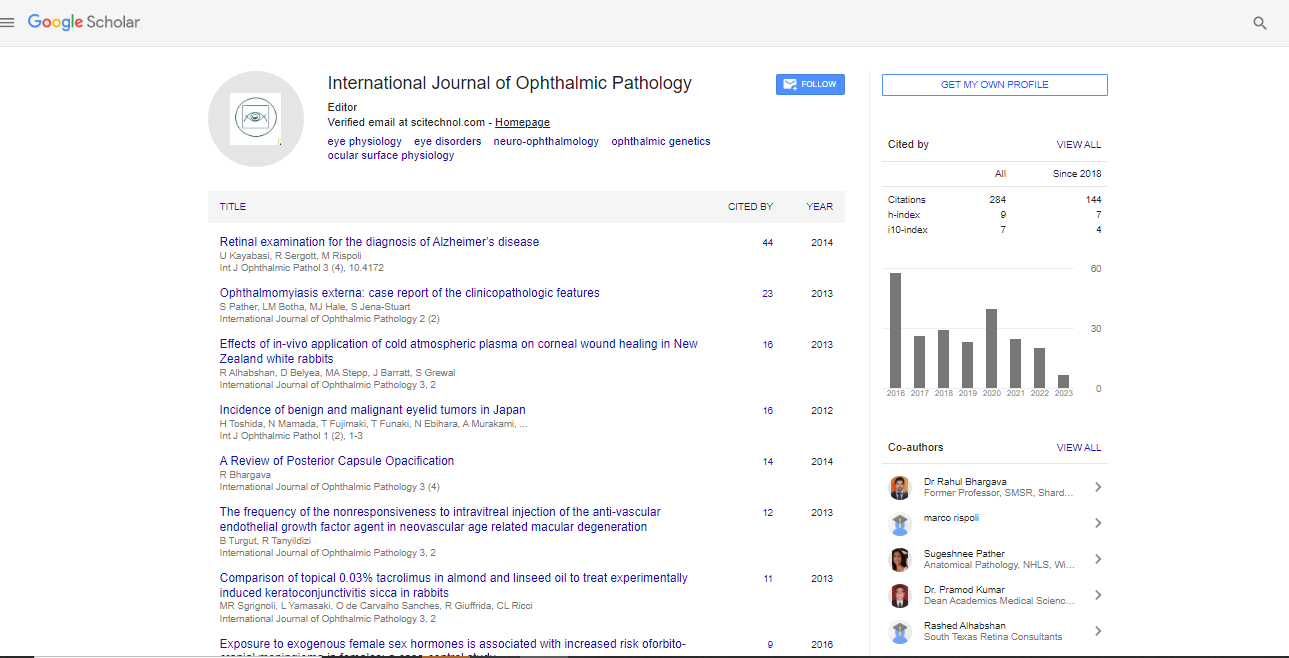Commentary, Int J Ophthalmic Pathol Vol: 10 Issue: 0
Visual Acuity the Clarity or Sharpness of Vision and its Measurement
Sophia Wang*
Department of Ophthalmology, Stanford University, California, USA
*Corresponding Author: Sophia Wang
Department of Ophthalmology, Stanford University, California, USA
E-mail: sywang@stanford.edu
Received: October 08, 2021 Accepted: October 22, 2021 Published: October 29, 2021
Citation: Wang S (2021) Visual Acuity the Clarity or Sharpness of Vision and its Measurement. Int J Ophthalmic Pathol S4.
Keywords: Contrast sensitivity, Clinical Evaluation
Introduction
Contrast sensitivity (CS) communicates the nature of human vision. This point presents the essential worries for the interpretation of CS and what plans of the eye and frontal cortex add to achieving it. There is still information on the ways and sorts of CS clinical evaluation, factors and conditions affecting it, and the latest creative enhancements in its assessment.
Visual acuity (VA) is the extent of the spatial objective of the eye (the clarity or sharpness of vision) and its assessment chooses the most raised spatial repeat or humblest detail that the eye can see at unquestionable levels of distinction .But V.A. is assessed on a decent even handed (optotype) and it very well may be the basic assessment of vision anyway doesn’t totally meet the step by step necessities of the human visual limit, which comes into contact with a variety of updates of evolving power [1].
Discussion
Contrast sensitivity (CS) is the limit of the eye to recognize little changes in lighting up at Centers around that don’t have indisputably described cut off points. Assessing C.S. is likewise essentially as huge as V.A. likewise, is as of now all around recognized as equal as it reflects the idea of vision and generally speaking abatements earlier, while V.A. stays standard (6/6 or better) [2]. C.S. portrays the edge among recognizable and non-clear, which has both simple and clinical significance in the investigation of vision. Vision is conceivably the most mentioning components of the human psyche. The introduction of visual upgrades into the eye and their way from its physical developments to its retinal photoreceptors is a condition that is related on various parts. Subsequently, moving overhauls from the retina to the occipital fold yet furthermore inspecting and deciphering them is a bewildered cycle including various bits of the psyche. The occasion of CS is extensively more tangled as the pieces of the physical developments of the optic nerve and the psyche that add to it have not been totally portrayed. Each eye is moreover an alternate case, with its own visual varieties making it essentially more irksome the examination of CS unequivocally [3].
Vision is one of the most requesting elements of the human mind. The presentation of visual boosts into the eye and their way from its physical constructions to its retinal photoreceptors is a condition that is reliant on many elements. Accordingly, moving improvements from the retina to the occipital projection yet additionally dissecting and interpreting them is a confounded cycle including many pieces of the mind. The instance of CS is considerably more muddled as the jobs of the physical designs of the optic nerve and the mind that add to it have not been completely characterized [4].
Each eye is additionally a different case, with its own visual abnormalities making it considerably more troublesome the investigation of CS precisely. At last, the tests utilized clinically don’t really have predictable outcomes, contingent upon a few variables (eye refractive blunders, surrounding light, age, patient focus - don’t stop to be important for the abstract assessment), just as not every one of them current tests perform similarly substantial for each situation (for example Vistech doesn’t give exact outcomes after refractive medical procedure) [5]. It is certain that studying the function of vision will always remain a pleasant challenge for scientists in the field. Research and the discovery of new methods for understanding the fascinating parts of the human eye and brain, as well as the connection between them, will not stop.
References
- Moseley MJ, Hill AR(1994) Contrast sensitivity testing in clinical practice. Br J Ophthalmol 78: 795-797.
- Wright CE, N Drasdo N (1985) The influence of age on the spatial and temporal contrast sensitivity function. Doc Ophthalmol 59: 385-395.
- Adams RJ, Courage ML (2002) Using a single test to measure human contrast sensitivity from early childhood to maturity. Vision Res 42: 1205-1210.
- Arden GB (1978) The importance of measuring contrast sensitivity in cases of visual disturbance. Br J Ophthalmol 62: 198-209.
- Woods RL, Wood JM (1995) The role of contrast sensitivity charts and contrast letter charts in clinical practice. Clin Exp Optom 78: 43-57.
 Spanish
Spanish  Chinese
Chinese  Russian
Russian  German
German  French
French  Japanese
Japanese  Portuguese
Portuguese  Hindi
Hindi 